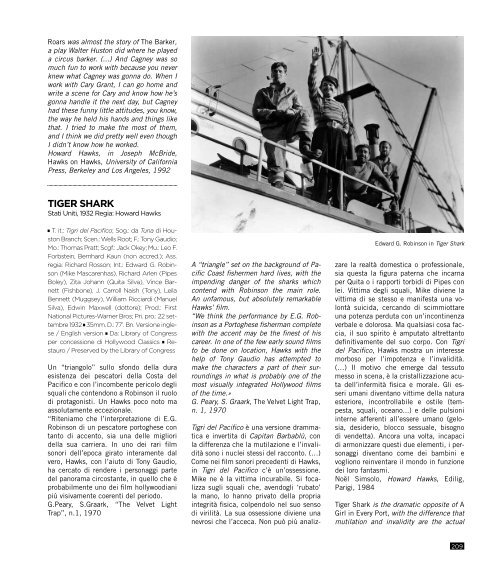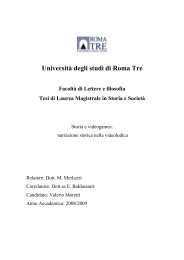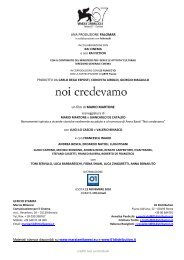Howard Hawks.pdf - Cineteca di Bologna
Howard Hawks.pdf - Cineteca di Bologna
Howard Hawks.pdf - Cineteca di Bologna
Create successful ePaper yourself
Turn your PDF publications into a flip-book with our unique Google optimized e-Paper software.
Roars was almost the story of The Barker,<br />
a play Walter Huston <strong>di</strong>d where he played<br />
a circus barker. (...) And Cagney was so<br />
much fun to work with because you never<br />
knew what Cagney was gonna do. When I<br />
work with Cary Grant, I can go home and<br />
write a scene for Cary and know how he’s<br />
gonna handle it the next day, but Cagney<br />
had these funny little attitudes, you know,<br />
the way he held his hands and things like<br />
that. I tried to make the most of them,<br />
and I think we <strong>di</strong>d pretty well even though<br />
I <strong>di</strong>dn’t know how he worked.<br />
<strong>Howard</strong> <strong>Hawks</strong>, in Joseph McBride,<br />
<strong>Hawks</strong> on <strong>Hawks</strong>, University of California<br />
Press, Berkeley and Los Angeles, 1992<br />
TIGER SHARK<br />
Stati Uniti, 1932 Regia: <strong>Howard</strong> <strong>Hawks</strong><br />
█ T. it.: Tigri del Pacifico; Sog.: da Tuna <strong>di</strong> Houston<br />
Branch; Scen.: Wells Root; F.: Tony Gau<strong>di</strong>o;<br />
Mo.: Thomas Pratt; Scgf.: Jack Okey; Mu.: Leo F.<br />
Forbstein, Bernhard Kaun (non accred.); Ass.<br />
regia: Richard Rosson; Int.: Edward G. Robinson<br />
(Mike Mascarenhas), Richard Arlen (Pipes<br />
Boley), Zita Johann (Quita Silva), Vince Barnett<br />
(Fishbone), J. Carroll Naish (Tony), Leila<br />
Bennett (Muggsey), William Ricciar<strong>di</strong> (Manuel<br />
Silva), Edwin Maxwell (dottore); Prod.: First<br />
National Pictures-Warner Bros; Pri. pro.: 22 settembre<br />
1932 █ 35mm. D.: 77’. Bn. Versione inglese<br />
/ English version █ Da: Library of Congress<br />
per concessione <strong>di</strong> Hollywood Classics █ Restauro<br />
/ Preserved by the Library of Congress<br />
Un “triangolo” sullo sfondo della dura<br />
esistenza dei pescatori della Costa del<br />
Pacifico e con l’incombente pericolo degli<br />
squali che contendono a Robinson il ruolo<br />
<strong>di</strong> protagonisti. Un <strong>Hawks</strong> poco noto ma<br />
assolutamente eccezionale.<br />
“Riteniamo che l’interpretazione <strong>di</strong> E.G.<br />
Robinson <strong>di</strong> un pescatore portoghese con<br />
tanto <strong>di</strong> accento, sia una delle migliori<br />
della sua carriera. In uno dei rari film<br />
sonori dell’epoca girato interamente dal<br />
vero, <strong>Hawks</strong>, con l’aiuto <strong>di</strong> Tony Gau<strong>di</strong>o,<br />
ha cercato <strong>di</strong> rendere i personaggi parte<br />
del panorama circostante, in quello che è<br />
probabilmente uno dei film hollywoo<strong>di</strong>ani<br />
più visivamente coerenti del periodo.<br />
G.Peary, S.Graark, “The Velvet Light<br />
Trap”, n.1, 1970<br />
A “triangle” set on the background of Pacific<br />
Coast fishermen hard lives, with the<br />
impen<strong>di</strong>ng danger of the sharks which<br />
contend with Robinson the main role.<br />
An unfamous, but absolutely remarkable<br />
<strong>Hawks</strong>’ film.<br />
“We think the performance by E.G. Robinson<br />
as a Portoghese fisherman complete<br />
with the accent may be the finest of his<br />
career. In one of the few early sound films<br />
to be done on location, <strong>Hawks</strong> with the<br />
help of Tony Gau<strong>di</strong>o has attempted to<br />
make the characters a part of their surroun<strong>di</strong>ngs<br />
in what is probably one of the<br />
most visually integrated Hollywood films<br />
of the time.»<br />
G. Peary, S. Graark, The Velvet Light Trap,<br />
n. 1, 1970<br />
Tigri del Pacifico è una versione drammatica<br />
e invertita <strong>di</strong> Capitan Barbablù, con<br />
la <strong>di</strong>fferenza che la mutilazione e l’invali<strong>di</strong>tà<br />
sono i nuclei stessi del racconto. (…)<br />
Come nei film sonori precedenti <strong>di</strong> <strong>Hawks</strong>,<br />
in Tigri del Pacifico c’è un’ossessione.<br />
Mike ne è la vittima incurabile. Si focalizza<br />
sugli squali che, avendogli ‘rubato’<br />
la mano, lo hanno privato della propria<br />
integrità fisica, colpendolo nel suo senso<br />
<strong>di</strong> virilità. La sua ossessione <strong>di</strong>viene una<br />
nevrosi che l’acceca. Non può più analiz-<br />
Edward G. Robinson in Tiger Shark<br />
zare la realtà domestica o professionale,<br />
sia questa la figura paterna che incarna<br />
per Quita o i rapporti torbi<strong>di</strong> <strong>di</strong> Pipes con<br />
lei. Vittima degli squali, Mike <strong>di</strong>viene la<br />
vittima <strong>di</strong> se stesso e manifesta una volontà<br />
suicida, cercando <strong>di</strong> scimmiottare<br />
una potenza perduta con un’incontinenza<br />
verbale e dolorosa. Ma qualsiasi cosa faccia,<br />
il suo spirito è amputato altrettanto<br />
definitivamente del suo corpo. Con Tigri<br />
del Pacifico, <strong>Hawks</strong> mostra un interesse<br />
morboso per l’impotenza e l’invali<strong>di</strong>tà.<br />
(…) Il motivo che emerge dal tessuto<br />
messo in scena, è la cristallizzazione acuta<br />
dell’infermità fisica e morale. Gli esseri<br />
umani <strong>di</strong>ventano vittime della natura<br />
esteriore, incontrollabile e ostile (tempesta,<br />
squali, oceano...) e delle pulsioni<br />
interne afferenti all’essere umano (gelosia,<br />
desiderio, blocco sessuale, bisogno<br />
<strong>di</strong> vendetta). Ancora una volta, incapaci<br />
<strong>di</strong> armonizzare questi due elementi, i personaggi<br />
<strong>di</strong>ventano come dei bambini e<br />
vogliono reinventare il mondo in funzione<br />
dei loro fantasmi.<br />
Noël Simsolo, <strong>Howard</strong> <strong>Hawks</strong>, E<strong>di</strong>lig,<br />
Parigi, 1984<br />
Tiger Shark is the dramatic opposite of A<br />
Girl in Every Port, with the <strong>di</strong>fference that<br />
mutilation and invali<strong>di</strong>ty are the actual<br />
209
















